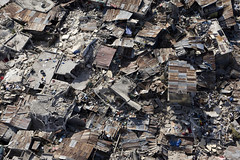May 31, 2010
Cell-Phone Activity For Predicting Earthquakes
 Photo courtesy of United Nations Development Programme |
An organization called Artificial Intelligence for Development (AI-D) recently had a workshop at Stanford which looked at ways that data driven statistical modeling and prediction could be used to help under-served populations in the developing world. One of the papers that came out of that conference was called "People, Quakes, and Communications: Inferences from Call Dynamics about a Seismic Event and its Influences on a Population". It was written by researchers at Microsoft and at the Santa Fe Institute, Ashish Kapoor, Eric Horvitz, and Nathan Eagle. They are all terrific researchers who have a much better track record than I do. The basic foundation for the paper was a large dataset of calls that were made in Rwanda in 2008. During this time frame an earthquake with a 5.9 magnitude occurred. The paper examined ways of determining: |
In terms of determining where an earthquake happened, the paper actually recognized that something unusual happened that affected call patterns. It was not correct to say that it recognizes earthquakes, but when applied to the data that contained an earthquake, it did recognize the earthquake as out of the usual.
In terms of determining where it happened, the paper assumed a model in which the the degree of unusualness fell off with the proposed distance from the closest call tower. The problem of finding where the earthquake occurred then reduced to a search over all locations for the location that best explained the observed disruption. I think this approach would work for a brief moment after an earthquake occurs, when call pattern disruption is dominated by calls in and out of the immediately affected area, but I think that very quickly calls would start being made all over the place as word spread regionally. This approach also assumes that an earthquake only really affects one location, that locations are defined by the cell phone towers and that there is a cell phone tower where the earthquake occurs.
In terms of the final contribution, I didn't understand the paper's approach. At a high level it was a decision theoretic approach that argued for surveying unknown locations that reduce uncertainty the most. But in terms of cell-phone data, how is it that you don't have the data already? What does it mean to go survey an unknown location for cell-phone activity? The math was pretty complex when you start to apply the DT approach, so I may have missed something here. Nevertheless the motivation was cool. Wouldn't it be nice to have a disaster management computer that told you where you would benefit the most by sending scouts?
Despite my critique, this paper was exciting because it contained real meaningful data and took a well-grounded stab at solving an important and hard problem.

